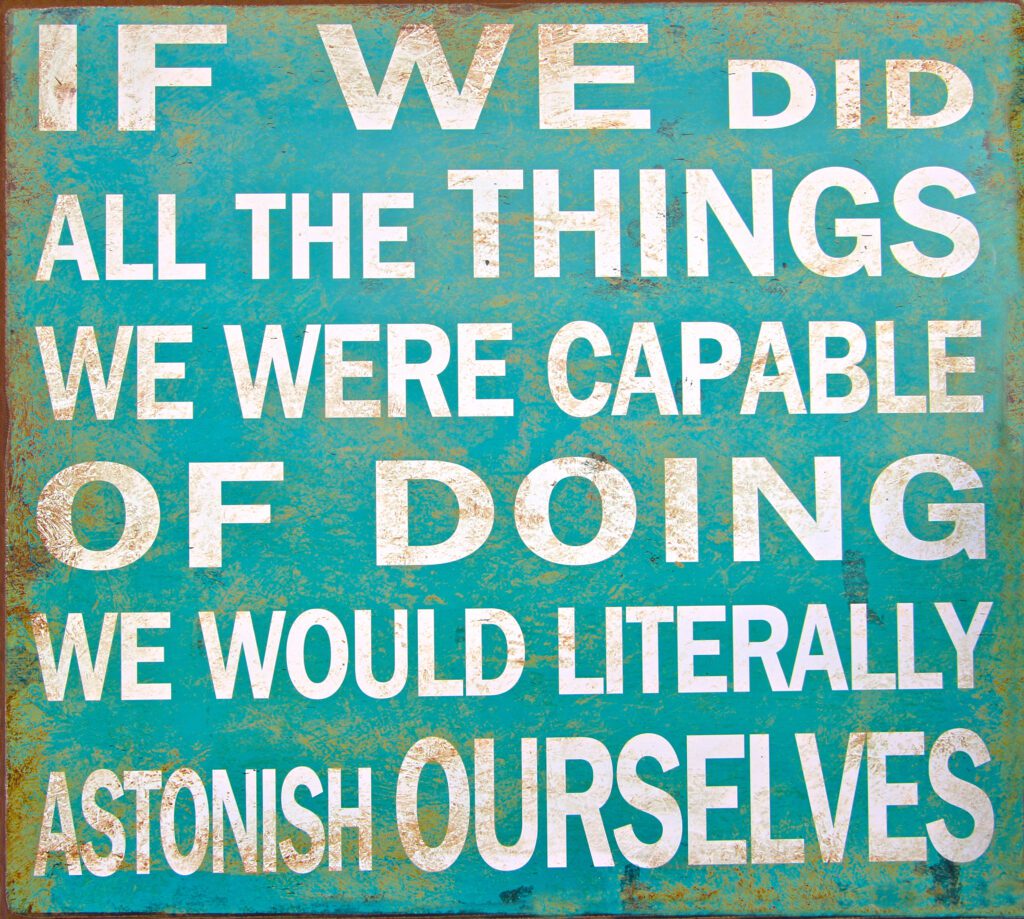“Imagination is more important than knowledge. For knowledge is limited to all we now know and understand, while imagination embraces the entire world, and all there ever will be to know and understand.”
– Albert Einstein
Want a Superpower?

Unlocking your creative potential might just be the closest thing to a superpower that’s accessible to all of us. Creativity isn’t just for the select few lucky enough to be ‘born with it.’ It’s a skill we can harness, nurture, and grow within ourselves over time. Whether you’re a CEO, an artist, a student, or someone looking to add a splash of ingenuity to your daily life, here are 10 proven strategies to elevate your creativity to new heights.
1. Embrace Curiosity
Always Question and Explore
Curiosity is the quiet whisper of the creative muse. It begins with asking “why” and doesn’t end until you’re standing at the edge of the unknown. Cultivate a habit of inquiry – be it learning a new topic, or considering alternative paths for a project. Explore the corners of your imagination that you’ve yet to dust off and allow curiosity to be your compass.
Curiosity not only leads us to new discoveries but also to the rediscovery of familiar territories with fresh eyes. Embrace the journey of questioning the status quo, and let each answer pave the way for deeper, more intricate questions. This relentless pursuit of knowledge fuels innovation and creativity, transforming the mundane into extraordinary. By allowing curiosity to guide your explorations, you unlock a world where possibilities are limitless and every answer is a gateway to further wonderment.
Explore Divergent Thinking
Divergent thinking stands as a cornerstone of creativity, offering a multitude of benefits that stretch the boundaries of imagination. By encouraging the generation of multiple solutions to a given problem, it fosters a rich environment for innovation and problem-solving. This way of thinking promotes flexibility, enabling individuals to explore a wide array of possibilities rather than being confined to conventional solutions.
It enhances cognitive nimbleness, making it easier to pivot between different ideas and perspectives. Moreover, divergent thinking cultivates a sense of curiosity and openness, encouraging individuals to question assumptions and explore new territories. This approach not only leads to more creative outcomes but also bolsters resilience by equipping individuals with a diverse toolkit of strategies to tackle challenges, ensuring they are better prepared to navigate the complexities of both their personal and professional lives.
2. Create an Inspiring Environment
Location Can Be a Motivation
Your physical surroundings can make or break creative flow. Think about the times you’ve felt most inspired – what did your environment look like? Opt for spaces filled with colors, textures, and items that evoke positive emotions and memories. Consider natural light, plants, and quiet corners. Create an environment that feeds your creativity, and you’ll find your ideas flourish. Sometimes, stepping into a new environment like a bustling coffee shop or a serene park can spark a surge of creativity. The change of scenery can provide fresh perspectives and inspiration, allowing your creative juices to flow in unexpected ways.
3. Practice Mindfulness

The Power of Now
Mindfulness is more than a buzzword; it’s a fundamental practice for unleashing creative potential. By focusing on the current moment, you free yourself from the chains of past failures and future anxieties. Meditate, take a walk and breathe in the present. When you can quiet the mental noise, you create a fertile ground for innovative ideas. Engaging in mindfulness practices not only helps in reducing stress but also enhances your ability to observe and appreciate the subtleties in your environment and experiences. This heightened awareness can lead to breakthroughs in creativity, as you begin to see connections and possibilities that were previously overlooked.
Start small if you want to. Studies have shown that meditating for as little as 5 minutes a day can help to reduce stress, relax your mind and promote creativity.
4. Collaborate and Brainstorm
The Whole Is Greater Than the Sum
Sometimes, the best way to boost your creativity is to seek it in others. Collaborative environments and brainstorming sessions can lead to a symphony of innovative ideas. Diverse perspectives open new doors and help you view challenges from a fresh angle. Don’t shy away from interaction; it’s often where the most creative sparks fly.
“Creativity consists of coming up with many ideas, not just that one great idea.”
– Charles Thompson
Embrace the dynamic energy of group discussions and the synergy that comes from working together towards a common goal. This shared journey not only enriches the creative process but also strengthens connections, making the path to innovation a collective achievement.
5. Make Time for Play
Bring Out the Inner Child
Play isn’t just for kids. Engaging in activities without a specific outcome in mind can lead to some of the most revolutionary ideas. Whether it’s a hobby, game, or playful experiment, the act of unstructured enjoyment is a breeding ground for creativity. Play allows our minds to wander and break free from the constraints of daily routine.
6. Keep a Creativity Journal

Document Your Eureka Moments
Creativity can be elusive – that’s where a journal comes in. Document all your ideas, no matter how big or small. This isn’t about creating a to-do list; it’s about capturing the essence of inspiration before it slips away. When you’re in need of a creative spark, your journal will serve as a gold mine of potential projects and solutions.
Looking for inspiration? Utilizing journal prompts can ignite creativity by providing a structured starting point that encourages exploration and innovation in your thoughts and ideas.
7. Seek Feedback
Constructive Criticism as a Compass
Fear of judgment can be the enemy of creativity. But feedback – good or bad – is fuel for improvement. It provides a different lens through which to view your work and offers insights you could never gain on your own. Learn to differentiate between criticism and critique, and use it to refine your ideas into their best form.
Welcoming constructive criticism is akin to navigating the creative process with a compass that points towards growth and excellence. It’s an invaluable tool that encourages you to view your work objectively and embrace an open-minded approach to feedback. This mindset fosters an environment of continuous learning and adaptation, enabling you to sift through diverse opinions and extract valuable insights.
8. Step Out of Comfort Zones

The Unknown Is a Well of Inspiration
Growth and creativity often reside just beyond the boundary of comfort. To push the boundaries of your creativity, you must push the boundaries of your experience. Do things you’re not accustomed to, travel to unfamiliar places, and challenge your established thought patterns. These new experiences will knock loose fresh thoughts and novel ideas.
9. Find Inspiration Everywhere
Open Your Senses to the World
Cliché as it seems, the world is your canvas, and inspiration can strike anywhere. Observe the details in all things. What story lies within that tree’s gnarled bark or the pattern of coffee spilled on a table? By seeing the extraordinary in the ordinary, you’ll never run out of fuel for your creative fire.
10. Prioritize Self-Care
Nourish Your Inner Flame
Creativity draws from a deep well. To keep it flowing, you need to prioritize self-care. Exercise, eat well, and get enough sleep. Strive for a good balance between work and relaxation. Nurturing your mental and physical health means ensuring that you’re in top shape to tackle creative challenges head-on.
Just as a garden requires consistent watering and sunlight to bloom, your creative spirit thrives when it’s regularly nurtured with activities that enrich both mind and body. Engage in physical activities that you enjoy, such as walking, cycling, or dancing, to energize your body and stimulate your mind. Make time for hobbies and interests outside of your creative pursuits to provide a refreshing break and introduce new ideas and perspectives. This dedicated effort to balance your physical activities and leisure not only maintains your well-being but also ensures that your reservoir of creativity is continually replenished, keeping your inner flame bright and your potential for innovation limitless.
In Conclusion
Our potential for creativity is as boundless as our imagination, and these tips are the keys to unlocking that potential. By infusing curiosity into our daily lives, creating supportive environments, practicing mindfulness, collaborating, finding time to play, journaling, seeking feedback, exploring new experiences, finding inspiration everywhere, and prioritizing self-care, we cultivate the fertile ground where creativity not only thrives, but transforms how we approach the world. Remember, it’s a journey – not a race. Start with one tip at a time, and watch as your innovative capacities expand, enriching both your personal and professional worlds.
Frequently Asked Questions (FAQ)
1. How can I develop a habit of being creative every day?
A: Start small by integrating creativity into your daily routine. This could be as simple as dedicating time to brainstorm ideas, sketching, writing, or engaging in any activity that sparks your interest. Consistency is key, and with time, creativity will become a natural part of your daily life.
2. What should I do if I hit a creative block?
A: When facing a creative block, it’s often helpful to change your environment, take a break, or try a completely different activity. This shift can provide a new perspective and may help ideas flow again. Remember, it’s alright to step away and recharge.
3. Can creativity be learned, or is it a natural talent?
A: Creativity is both a learnable skill and a natural talent. While some people might possess a natural inclination towards creative thinking, creativity is something that can be fostered and enhanced through practice, exposure to different experiences, and the courage to explore new ideas.
4. How important is collaboration for creativity?
A: Collaboration is incredibly beneficial for creative growth. It allows you to see things from different perspectives, combines diverse skill sets, and often leads to innovative solutions that may not have been possible individually. Collaboration can spark creativity and inspire new ideas.
5. Do all creative endeavors have to be original?
A: Not necessarily. Creativity often involves connecting existing ideas in new ways. It’s about personal expression and finding unique perspectives on familiar concepts. Originality is just one aspect of creativity; the value lies in how you interpret and reimagine what exists.
Recommended Reading
Creativity, Inc. by Ed Catcall

Creativity: Flow and the Psychology of Discovery and Invention by Mihaly Csikszentmihalyi

A Whack on the Side of the Head by Roger von Oech



